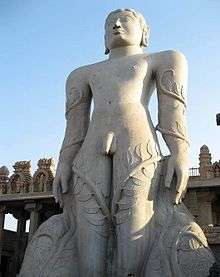Kayotsarga

| Part of a series on |
| Jainism |
|---|
 |
|
Jain prayers |
|
Ethics |
|
Major figures |
|
Major sects |
|
Festivals |
|
Pilgrimages |
|
|
Kayotsarga (Sanskrit: कायोत्सर्ग Kāyōtsarga), Magadhi Prakrit: काउस्सग्ग Kāussagga is a yogic posture which is an important part of the Jain meditation. It literally means "dismissing the body".[1][2] A tirthankara is represented either seated in yoga posture or standing in the Kayotsarga posture.[3] Kayotsarga means to give up one's physical comfort and body movements, thus staying steady, either in a standing or other posture, and concentrating upon the true nature of the soul. It is one of the six essentials (avasyaka) of a Jain ascetic.[4] It is one of the 28 primary attributes of a Digambara monk
Twenty-one of the tīrthankaras of Jainism are said to have attained moksha in the kayotsarga “standing meditation” posture. A famous example of unflinching standing meditation is that of Arihant Bahubali who is said to have stood in Kayotsarga for a year.[5]
Sāmayika
In performing sāmayika (daily meditation), the śrāvaka has to stand facing north or east and bow to the Pañca-Parameṣṭhi.[6] He then sit down and recites the Namokara mantra a certain number of times, and finally devotes himself to holy meditation. This consists in:[7]
- pratikramana, recounting the sins committed and repenting for them,
- pratyākhyanā, resolving to avoid particular sins in future,
- sāmayika karma, renunciation of personal attachments, and the cultivation of a feeling of regarding every body and thing alike,
- stuti, praising the four and twenty Tīrthankaras,
- vandanā, devotion to a particular Tirthankara, and
- kāyotsarga, withdrawal of attention from the body (physical personality) and becoming absorbed in the contemplation of the spiritual Self.
Notes
- ↑ Zimmer 1953, p. 210.
- ↑ "Kayotsarga: A jaina technique of relaxation". http://www.merinews.com. 8 May 2010. External link in
|journal=(help) - ↑ Zimmer 1953, p. 209-210.
- ↑ "The nature of the Whole: Holism in Ancient Greek and Indian Medecine". https://books.google.ch. External link in
|journal=(help) - ↑ Zimmer 1953, p. 212.
- ↑ Jain 1917, p. 44, 61.
- ↑ Jain 1917, p. 45.
References
- Zimmer, Heinrich (1953), Joseph Campbell, ed., Philosophies Of India, London, E.C. 4: Routledge & Kegan Paul Ltd, ISBN 978-8120807396
- Jain, Champat Rai (1917), The Householder's Dharma: English Translation of The Ratna Karanda Sravakachara, The Central Jaina Publishing House